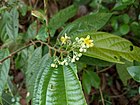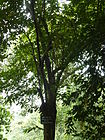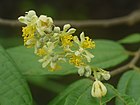Note: This is a project under development. The articles on this wiki are just being initiated and broadly incomplete. You can Help creating new pages.
Difference between revisions of "Microcos paniculata"
| Line 33: | Line 33: | ||
==Identification== | ==Identification== | ||
===Leaf=== | ===Leaf=== | ||
| − | {{Leaf|Simple| Leaves 3-costate, elliptic-lanceolate or ovate-lanceolate|8.5-13.5 cm long, 4-5.5 cm broad glabrous except for stellate hairs on veins and veinlets beneath, entire or slightly serrate | + | {{Leaf|Simple| Leaves 3-costate, elliptic-lanceolate or ovate-lanceolate|8.5-13.5 cm long, 4-5.5 cm broad glabrous except for stellate hairs on veins and veinlets beneath, entire or slightly serrate.}}<ref name="Leaf"/> |
===Flower=== | ===Flower=== | ||
{{Flower|Unisexual|8-15 cm long|Yellowish-white||8-10 mm across; pedicels small, hairy; bracts subulate, c. 3-4 mm long, caducous. Sepals linear-oblong, 6-7 mm long, 2.5-3 mm broad, densely hairy outside, cucullate at the apex.}} | {{Flower|Unisexual|8-15 cm long|Yellowish-white||8-10 mm across; pedicels small, hairy; bracts subulate, c. 3-4 mm long, caducous. Sepals linear-oblong, 6-7 mm long, 2.5-3 mm broad, densely hairy outside, cucullate at the apex.}} | ||
| − | |||
===Other features=== | ===Other features=== | ||
| Line 64: | Line 63: | ||
==References== | ==References== | ||
<references> | <references> | ||
| − | <ref name="chemical composition">[https://www.researchgate.net/publication/12471135_Insecticidal_piperidine_alkaloid_from_Microcos_paniculata_stem_bark | + | <ref name="chemical composition">[https://www.researchgate.net/publication/12471135_Insecticidal_piperidine_alkaloid_from_Microcos_paniculata_stem_bark Sciencedirect]</ref> |
| − | <ref name="Leaf">[http://www.flowersofindia.net/catalog/slides/Shiral.html | + | <ref name="Leaf">[http://www.flowersofindia.net/catalog/slides/Shiral.html Botonomy]</ref> |
| − | <ref name="How to plant/cultivate">[ | + | <ref name="How to plant/cultivate">[Cultivation]</ref> |
</references> | </references> | ||
Revision as of 17:44, 23 June 2020
Microcos paniculata is a flowering shrub native to China and south-east Asia. It is sometimes added to Chinese herbal tea, having a mildly sour taste. In traditional Chinese medicine the plant is believed to help the digestive system.
Contents
- 1 Uses
- 2 Parts Used
- 3 Chemical Composition
- 4 Common names
- 5 Properties
- 6 Habit
- 7 Identification
- 8 List of Ayurvedic medicine in which the herb is used
- 9 Where to get the saplings
- 10 Mode of Propagation
- 11 How to plant/cultivate
- 12 Commonly seen growing in areas
- 13 Photo Gallery
- 14 References
- 15 External Links
Uses
Colds, Hepatitis, Hepatitis, Diarrhea, Heat stroke, Dyspepsia.
Parts Used
Chemical Composition
The stem bark of Microcos paniculata contained a new alkaloid, N-Methyl-6 beta-(deca-1',3',5'-trienyl)-3 beta-methoxy-2 beta-methylpiperidine, which showed good insecticidal activity against Aedes aegypti second instar larvae.[1]
Common names
| Language | Common name |
|---|---|
| Kannada | |
| Hindi | Pahari Pudina |
| Malayalam | |
| Tamil | |
| Telugu | |
| Marathi | NA |
| Gujarathi | NA |
| Punjabi | NA |
| Kashmiri | NA |
| Sanskrit | |
| English | Spearmint, Garden mint, Lamb mint |
Properties
Reference: Dravya - Substance, Rasa - Taste, Guna - Qualities, Veerya - Potency, Vipaka - Post-digesion effect, Karma - Pharmacological activity, Prabhava - Therepeutics.
Dravya
Rasa
Guna
Veerya
Vipaka
Karma
Prabhava
Habit
Identification
Leaf
| Kind | Shape | Feature |
|---|---|---|
| Simple | Leaves 3-costate, elliptic-lanceolate or ovate-lanceolate | 8.5-13.5 cm long, 4-5.5 cm broad glabrous except for stellate hairs on veins and veinlets beneath, entire or slightly serrate. |
Flower
| Type | Size | Color and composition | Stamen | More information |
|---|---|---|---|---|
| Unisexual | 8-15 cm long | Yellowish-white | 8-10 mm across; pedicels small, hairy; bracts subulate, c. 3-4 mm long, caducous. Sepals linear-oblong, 6-7 mm long, 2.5-3 mm broad, densely hairy outside, cucullate at the apex. |
Other features
List of Ayurvedic medicine in which the herb is used
Where to get the saplings
Mode of Propagation
How to plant/cultivate
Commonly seen growing in areas
Eastern Bengal, Khasia mountains
Photo Gallery
References
- ↑ Sciencedirect
- ↑ Botonomy
- ↑ [Cultivation]
External Links
- Ayurvedic Herbs known to be helpful to treat Colds
- Ayurvedic Herbs known to be helpful to treat Hepatitis
- Ayurvedic Herbs known to be helpful to treat Diarrhea
- Ayurvedic Herbs known to be helpful to treat Heat stroke
- Ayurvedic Herbs known to be helpful to treat Dyspepsia
- Herbs with Leaves used in medicine
- Herbs with common name in Hindi
- Herbs with common name in English
- Habit - Tree
- Index of Plants which can be propagated by Seeds
- Herbs that are commonly seen in the region of Eastern Bengal
- Herbs that are commonly seen in the region of Khasia mountains
- Herbs
- Tiliaceae




